The AnandTech Coffee Lake Review: Initial Numbers on the Core i7-8700K and Core i5-8400
by Ian Cutress on October 5, 2017 9:00 AM EST- Posted in
- CPUs
- Intel
- Core i5
- Core i7
- Core i3
- 14nm
- Coffee Lake
- 14++
- Hex-Core
- Hyperthreading
Grand Theft Auto V
The highly anticipated iteration of the Grand Theft Auto franchise hit the shelves on April 14th 2015, with both AMD and NVIDIA in tow to help optimize the title. GTA doesn’t provide graphical presets, but opens up the options to users and extends the boundaries by pushing even the hardest systems to the limit using Rockstar’s Advanced Game Engine under DirectX 11. Whether the user is flying high in the mountains with long draw distances or dealing with assorted trash in the city, when cranked up to maximum it creates stunning visuals but hard work for both the CPU and the GPU.
For our test we have scripted a version of the in-game benchmark. The in-game benchmark consists of five scenarios: four short panning shots with varying lighting and weather effects, and a fifth action sequence that lasts around 90 seconds. We use only the final part of the benchmark, which combines a flight scene in a jet followed by an inner city drive-by through several intersections followed by ramming a tanker that explodes, causing other cars to explode as well. This is a mix of distance rendering followed by a detailed near-rendering action sequence, and the title thankfully spits out frame time data.
There are no presets for the graphics options on GTA, allowing the user to adjust options such as population density and distance scaling on sliders, but others such as texture/shadow/shader/water quality from Low to Very High. Other options include MSAA, soft shadows, post effects, shadow resolution and extended draw distance options. There is a handy option at the top which shows how much video memory the options are expected to consume, with obvious repercussions if a user requests more video memory than is present on the card (although there’s no obvious indication if you have a low-end GPU with lots of GPU memory, like an R7 240 4GB).
To that end, we run the benchmark at 1920x1080 using an average of Very High on the settings, and also at 4K using High on most of them. We take the average results of four runs, reporting frame rate averages, 99th percentiles, and our time under analysis.
All of our benchmark results can also be found in our benchmark engine, Bench.
MSI GTX 1080 Gaming 8G Performance
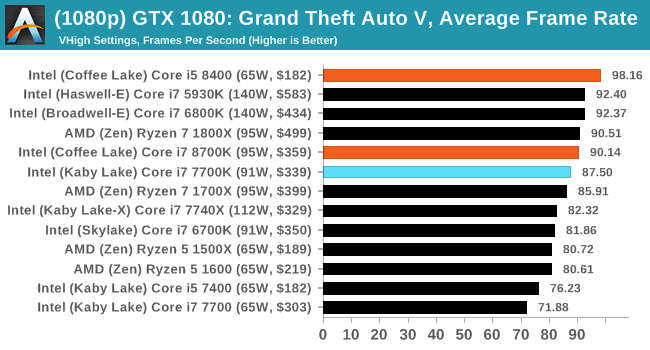
1080p

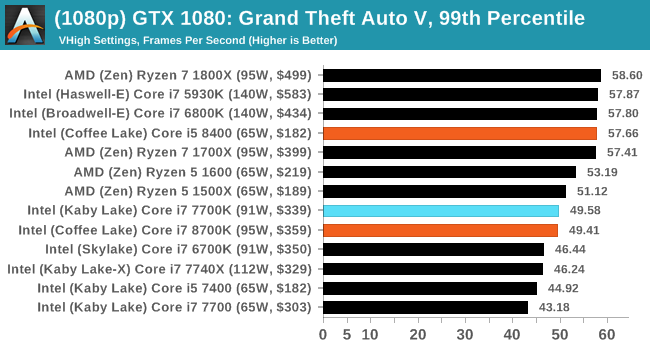
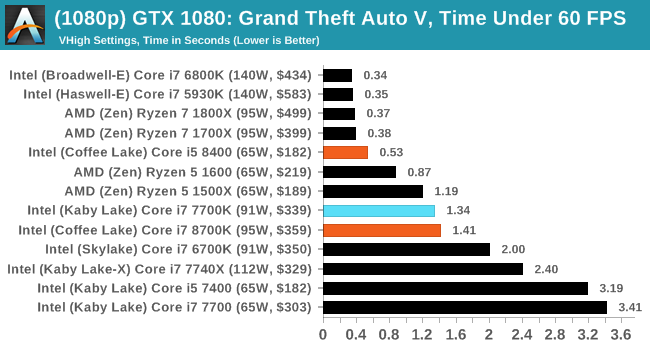
4K
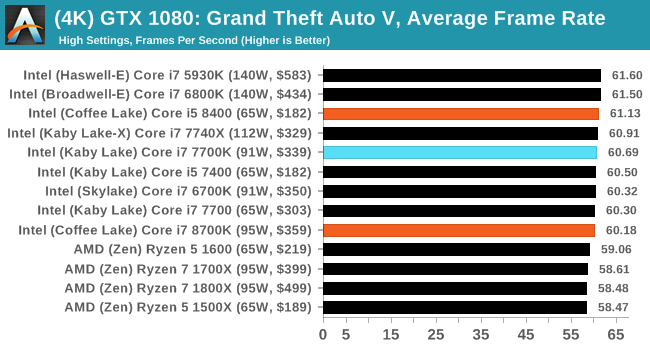
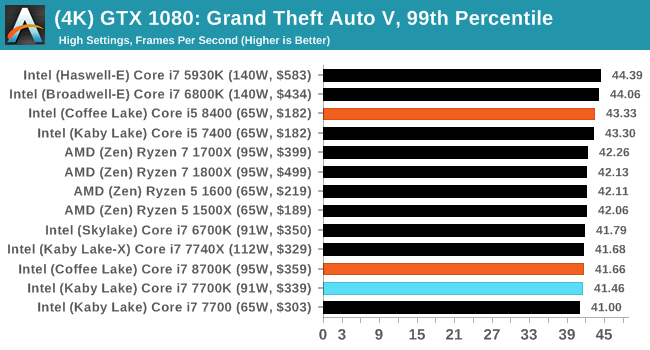




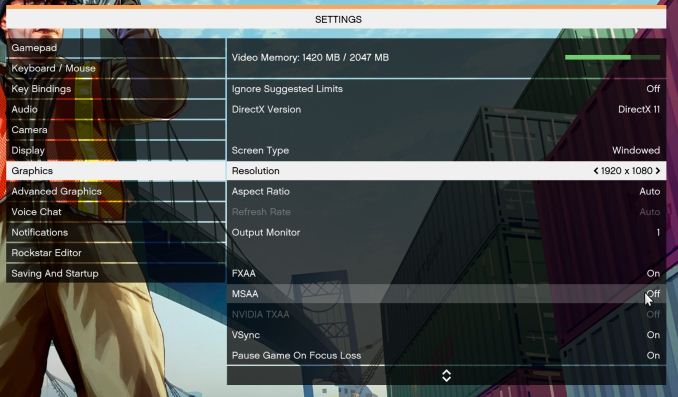








222 Comments
View All Comments
watzupken - Saturday, October 7, 2017 - link
There are pros and cons of having integrated graphics. It sure takes up a lot of die space, but it is something that allows Intel to sell a lot of chips. Amongst enthusiasts, this is unnecessary, but this group may only represent a small percentage vs corporates that need only decent CPU and no need for fancy graphics. To be honest, Intel could likely have created a 8 core processor easily since the die size is still fairly small for Coffee Lake, but they chose not to. I don't think it is a matter of the graphic that is holding them back.James5mith - Friday, October 6, 2017 - link
Now to wait for the generation of Intel CPU's with native Thunderbolt3 on-die like Intel announced earlier this year.Zingam - Saturday, October 7, 2017 - link
Why is that a good thing?ReeZun - Friday, October 6, 2017 - link
"The difference between the Ryzen 5 1500X and the Core i3-8350K would be interesting, given the extreme thread deficit (12 threads vs 4) between the two."The 1500X houses 8 threads (not 12).
watzupken - Saturday, October 7, 2017 - link
The difference between the R5 1500X and i3 8350K goes beyond just the number of threads. The cache is also 2x more on the Ryzen chip. However, the i3 chip have the advantage of being able to reach higher clockspeed. I do agree that this will be an interesting comparison.sweeper765 - Friday, October 6, 2017 - link
I'm not up to date with current bios versions.Is multi-core enhancement still present in z370 motherboards? That would get rid of all those differences in turbo speeds. I know it is technically overclocking but i bet it's a pretty safe procedure without increasing the voltages.
Also, what's the deal with the 8700? Is it just as good as 8700k (minus 100mhz) if one decides not to overclock? Just trying to gather as many practical facts as i can before formulating an upgrade plan (sandy bridge user hehe )
This cpu family looks good on specs and benches (maybe the first worthy successor to sandy bridge) but it's not perfect. I hate that Intel decided not to solder, i expect temperatures to soar in the high 80's. Also the current motherboards are somewhat lacking in ports (usb, lan, sata).
I love my sandy bridge setup though.
6 1/2 years old and still going strong. Overclocked, cool, stable, silent. With current cpu's you don't get all these points.
Even if i upgrade i'm not going to touch it.
Ian Cutress - Saturday, October 7, 2017 - link
Is multi-core enhancement still present in z370 motherboards?As an option, yes.
As default? Will vary board to board. You can disable it.
However we had trouble with one of our boards: disabling MCT/MCE and then enabling XMP caused the CPU to sit at 4.3 GHz all day. Related to a BIOS bug which the vendor updated in a hurry.
Jodiuh - Friday, October 6, 2017 - link
What’s up with those rise of Tomb Raider benchmarks? Am I too seriously believ the i5 7400 is more capable than the 8700K...did I miss the overclocking part?Tech reports review much better with results that make sense.
peevee - Friday, October 6, 2017 - link
"Core i5-8600K and the Core i7-8700. These two parts are $50 apart, however the Core i7-8700 has double the threads, +10% raw frequency"+10%? Count again.
boeush - Friday, October 6, 2017 - link
Regarding most normal/gaming scenarios, I'm wondering with the 8700/k whether one couldn't get an even better performance by disabling hyperthreading in the UEFI.That would still yield 6 threads, but now ostensibly with a full 2 MB of L3 per thread. Plus, lower power per core (due to lower resource utilization) might mean more thermal headroom and higher overall sustained frequencies.
So you'd get maximum-possible single-thread performance while still being able to run 6-wide SMT (which, under most normal usage, isn't even a constraint worth noting...)
Amirite?